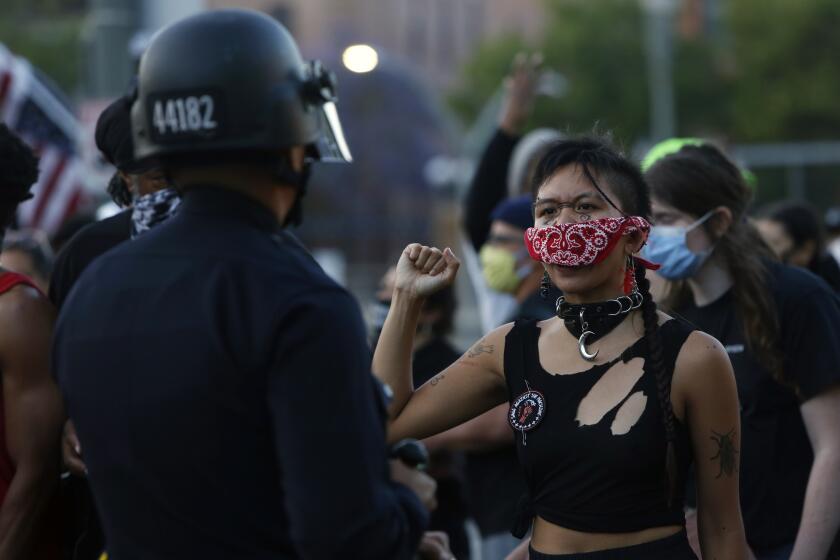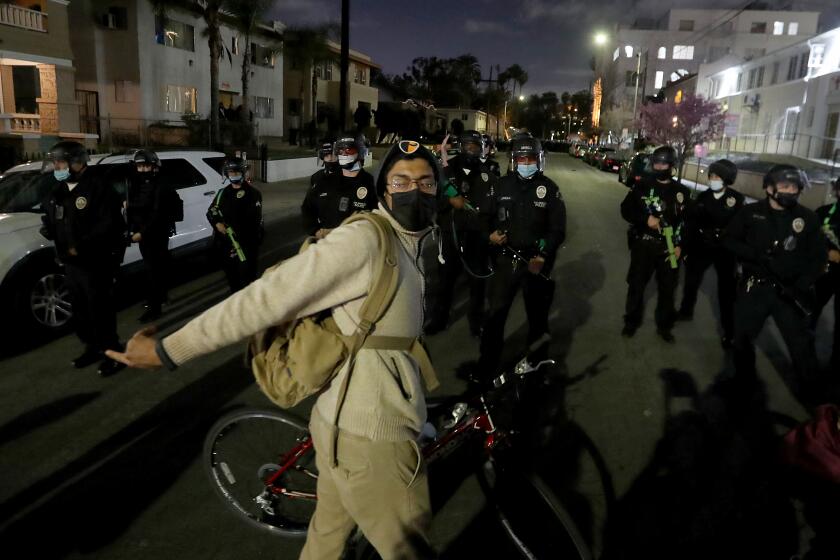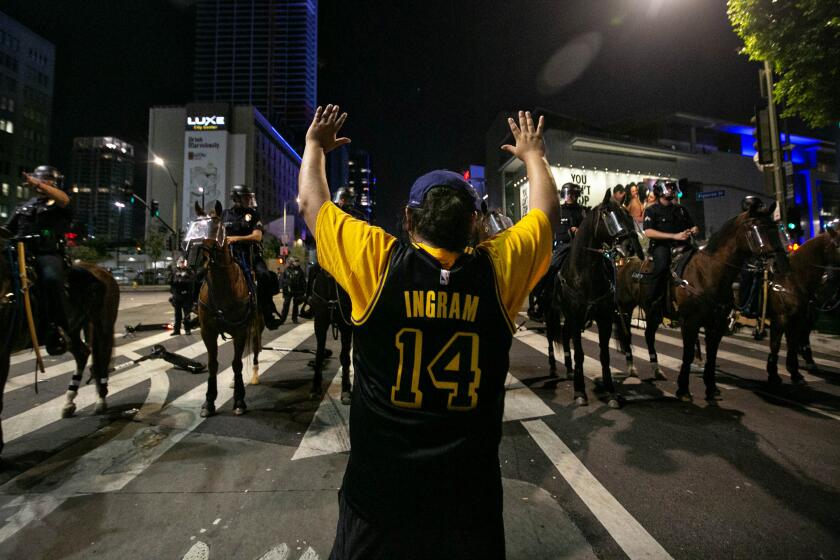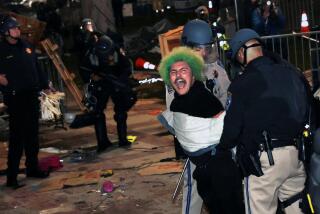LAPD lifts ban on some hard-foam projectile weapons at protests after judge revises order
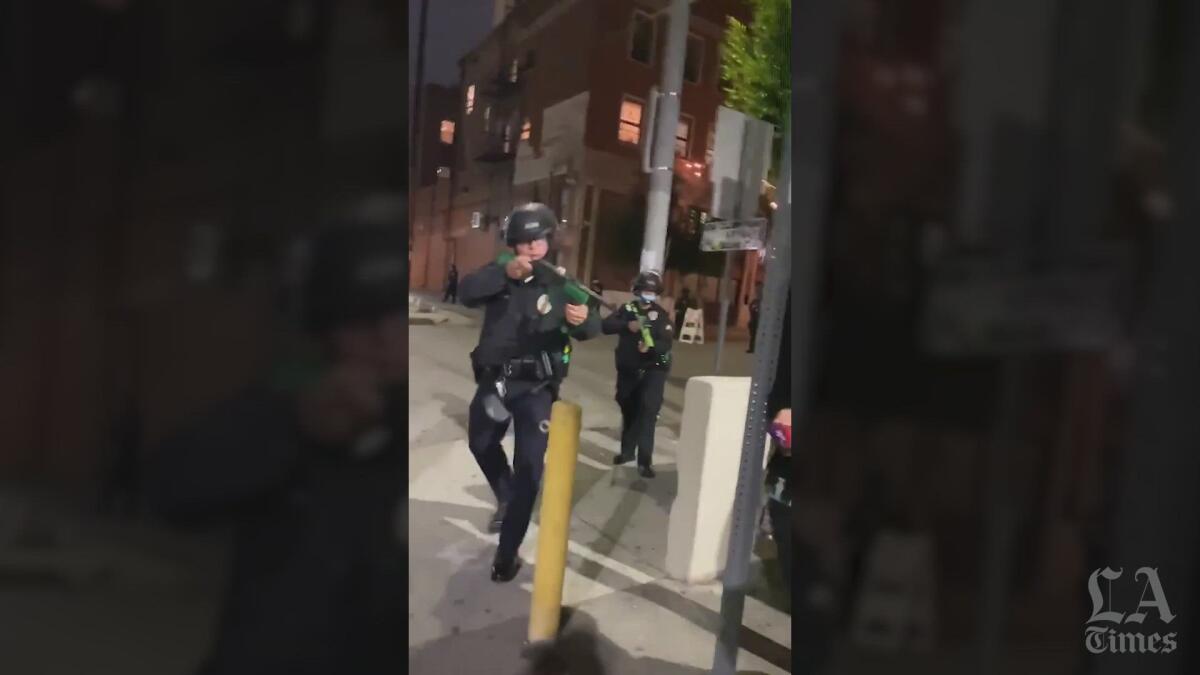
- Share via
The Los Angeles Police Department has lifted a week-old moratorium on the use of certain hard-foam projectiles at protests after a federal judge revised her recent court order restricting the weapons’ use.
The LAPD confirmed Thursday that it is putting its 37-millimeter projectile launchers back in the field for use, albeit under several remaining restrictions in U.S. District Judge Consuelo B. Marshall’s revised restraining order.
“The LAPD appreciates the Court’s thorough review of all the facts and circumstances,” the department said in a statement to The Times. “We are committed to exercise the needed restraint in the use of crowd control tactics while also maintaining the critical need to protect the community, as well as our police officers.”
Marshall’s revised order, issued Wednesday, allows the LAPD to fire 37-millimeter hard-foam projectiles at the ground in front of protesters after declaring a gathering unlawful and issuing a dispersal order. It requires those weapons be used only by trained officers, and says they cannot be used to target individuals “unless absolutely necessary to prevent imminent serious bodily injury” to officers or others.
The LAPD issues a moratorium on using certain projectile weapons at protests after a federal judge rules for Black Lives Matter-L.A. and other groups.
The initial order said such weapons, which fire five foam rounds at a time, “may only be used on persons who pose a threat of serious bodily harm” to officers and others.
The swift reversal and lifting of the moratorium followed a whirlwind of court filings in the underlying case, which is a class-action lawsuit brought against the city by Black Lives Matter Los Angeles and other advocacy groups and protesters who allege widespread LAPD abuses at mass protests last spring.
How the LAPD uses its projectile weapons is just one aspect of that larger court case, but one that has attracted early attention from the court because of claims by the plaintiffs that they faced ongoing abuses in the streets unless the court intervened.
Marshall’s initial order sought to address those concerns swiftly, as both sides worked on arguments for and against more permanent restrictions. Her revised order represented a compromise in the process, coming at the request of attorneys for both the city and the protesters suing it.
The two sides had conferred in private in recent days to discuss the restrictions, and agreed to the modified language ahead of a more robust debate on the merits of the weapons next week, during a hearing scheduled at 10 a.m. Monday.
Carol Sobel, an attorney helping to represent the protesters, said the revised order still holds the LAPD to a higher standard than its own internal policies.
“We think this protects the right to protest and does not unreasonably restrict the LAPD,” Sobel said.
Like the initial order, the revised order also restricts the use of 40-millimeter hard-foam projectile launchers, which fire larger, single hard-foam rounds.
While the initial order restricted both the 37- and 40-millimeter weapons to officers who are trained and “certified” to use such weapons, the revised order says they may only be used by officers who are trained and “meet all annual qualification requirements.”
Echo Park protesters and others allege police used excessive force, raising new questions about crowd control tactics.
The initial order said the 40-millimeter projectiles were only to be used “on persons who pose a threat of serious bodily injury,” while the revised order said they may only be used “when the officer reasonably believes that a suspect is violently resisting arrest or poses an immediate threat of violence or physical harm.”
The initial order said the LAPD must give verbal orders to disperse before using the weapons. The revised order says an order must be given before 37-millimeter projectiles are used to clear crowds, and that the use of 40-millimeter projectiles — only on those presenting a physical threat — “should be preceded by a warning, if feasible.”
The initial order said the 40-millimeter weapon could not be used to target people’s heads, necks, face, eyes or spinal cords, and that neither of the weapons should be aimed at people’s upper bodies. The revised order says the 37-millimeter generally should not be used to target people, and the 40-millimeter weapon must not be used to target people’s heads, necks, face, eyes, kidneys, chest, groin or spine.
The new order also states that neither weapon should be used within five feet of a target “unless an officer or other person is attacked and there is a threat of imminent serious harm.”
The compromise does not resolve the broader dispute over the weapons, or the underlying claims by protesters that they were badly injured by such projectiles and faced “a likelihood of irreparable injury” at future protests.
The temporary restraining order was only designed to preclude certain actions on an emergency basis. On Monday, Marshall will hear arguments on whether she should issue a more substantive order, known as a preliminary injunction, which could maintain the restrictions until the larger court case over the LAPD’s handling of last spring’s protests is resolved.
The broader case could result in a settlement that further enshrines new restrictions on the LAPD’s use of such weapons, but there is no guarantee of such a result. Past court settlements had such results, though protesters say they are back in court now in part because the LAPD failed to heed them.
The Los Angeles Police Department’s use of so-called less-lethal projectiles for crowd control is facing new criticism after two men were badly injured during the downtown celebration after the Lakers’ championship win.
In addition to the fundamental claims of abuses and injury sustained by protesters last spring, the hearing Monday will likely delve into the claims by protesters that LAPD officers have continued to cause injury to protesters with their projectiles at more recent demonstrations, including in Tujunga, Hollywood and Echo Park.
Those claims were cited by Marshall in her decision to grant the temporary restraining order on the weapons. She had rejected a similar request in July, before finding that the latest claims bolstered the protesters’ argument about ongoing harm.
Sobel said she and her clients have submitted a “massive amount of evidence” supporting their claims that the LAPD has continued to use its projectile weapons violently against protesters and journalists. They alleged a woman was shot “point blank in the chest” with a projectile at an anti-Trump protest in Tujunga, causing her to need plastic surgery. They alleged a journalist was shot in the back from 50 feet away and knocked unconscious while filming a Hollywood protest over Breonna Taylor’s killing by Louisville, Ky., police. And they alleged several protesters and a news photographer were injured at an Echo Park protest last month over the clearing of a homeless encampment.
In rebuttal, city attorneys argued Marshall’s restrictions would “irreparably impact officers’ abilities to keep the community safe” during demonstrations where people commit violence and other crime, removing one of their only effective tools to disperse large, volatile crowds. They also submitted several declarations from officers and body-worn camera videos to argue that the officers at the more recent protests were justified in their actions and that the protesters had submitted incorrect information about their injuries.
During the Echo Park incident, which involved a small group of demonstrators who were apart from a larger group facing mass arrest, a protester named Nara Kim, Kim’s boyfriend and fellow protester Alex Kanegawa and news photographer Christian Monterrosa all said they were hit by projectiles.
However, the city, citing body-camera videos, argued their claims were irrelevant to Marshall’s order on the 37- and 40-millimeter rounds because Kim was actually struck with a baton and Kanegawa with a beanbag round. And while they acknowledged that Monterrosa was struck with a 40-millimeter projectile, they said that was an accident.
“An officer was aiming for Mr. Kanegawa and Ms. Kim, but the 40mm struck Mr. Monterrosa because he stepped into the line of fire,” the city said.
Attorneys and some of those who were shot have questioned the city’s interpretation of the body-camera video, as well as its argument that the Echo Park clash shouldn’t be relevant to the court’s discussion. Whether it was beanbag rounds or other projectile weapons, the video showed that officers aimed and fired projectile weapons above people’s waists, stuck them in people’s faces at close range and fired them into a small, moving crowd that represented no physical threat to the officers, the protesters said.
They said the officers’ actions put everyone at the scene — including other officers and journalists — at risk, as evidenced by their own admission that they accidentally shot Monterrsa, a credentialed news photographer, in the chest with a 40-millimeter projectile.
“It doesn’t really matter if it was an accident or not. They intended to hit somebody at close proximity, in a group that was just protesting,” Monterrosa said. “There was no need.”
Di Barbadillo, a protester whose own footage of the incident was submitted along with the body-camera video, said the fact that officers used projectile weapons in such a way is exactly why a restraining order is necessary.
“They are using them to scare and threaten people,” Barbadillo said.
More to Read
Sign up for Essential California
The most important California stories and recommendations in your inbox every morning.
You may occasionally receive promotional content from the Los Angeles Times.
